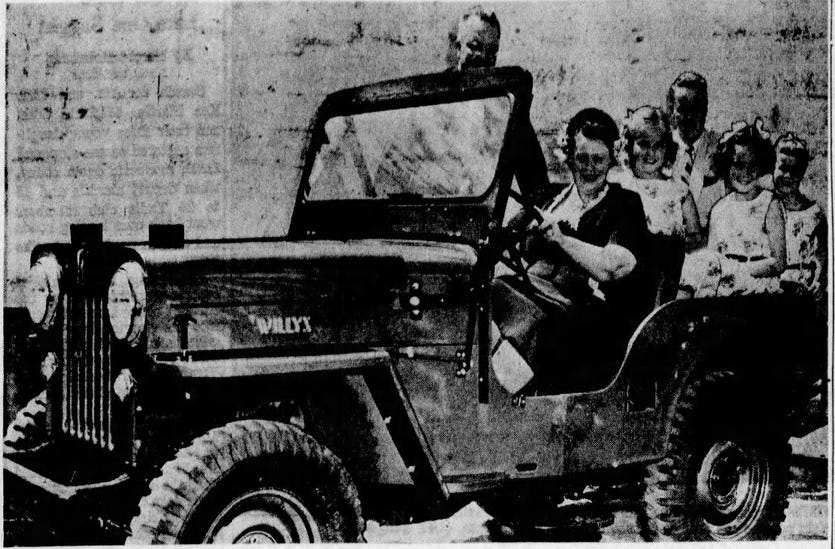(content warning for child deaths)
On Sunday, May, 4, 1959, the Columbia River was running high with spring runoff as tugboat operator Charles Isaman maneuvered the R. W. Confer through the water. Spotting a flash of something in the river something compelled Charles to bring the boat over for a closer look. And that’s when he spotted the body. Speaking with reporters soon after, the 39-year-old Isaman would say, “It really didn’t look like a body when I first saw it, but something made me want to go take a close look. As I got close, I could see legs and then an arm. I eased around the body and then went back to pick up by crew.”
Isaman said he towed the body onto a log raft, a collection of floating logs caught up in the spring waters, and secured it there until authorities could be brought out to the spot on the river, not far from Camas, Washington.
Within hours, the body would be identified as 10-year-old Susan Martin, still dressed in the clothing that she was last seen in five months earlier when she, and her entire family, disappeared from Portland, Oregon.
The next day, Clarence J. Haight, a veteran electrician for the US Army Engineers was walking the Bonneville Dam, almost 25 miles upstream from where Susan was found. As he walked along the spillway side of the dam, north of Bradford Island, he was checking on the gantry cranes. It’s there, caught up in debris pushed into the side of the dam, that he spotted the body of 12-year-old Virginia Martin. Like her sister, her body was still intact, but had also experienced decomposition. She was clothed, her jeans still rolled up into pedal pushers, some M&M wrappers tucked in her pockets.
The Martin family disappearance captured the nation’s attention from the beginning. On Sunday, December 7th, 1958, Kenneth Martin, 54, and his wife, Barbara, 48, gathered together their trio of girls, Barbara, Virginia, and Susan, to head out to gather some greenery to decorate their family home with for the holiday season. Because if there was one thing Kenneth was serious about, it was celebrating Christmas. In fact, Northeast 56th Avenue between Hancock and Broadway was unofficially known as Candy Cane Lane. As soon as the Christmas holiday approached, Kenneth would distribute large handmade candy canes to all the neighbors on the block so that they could display them outside their homes.
Pulling out of the driveway that afternoon, the Martin family honked cheerfully at some neighborhood teens before heading on their way. As usual, they were driving their 1954 Ford Country Squire station wagon. It was theirs by virtue of one of the many prizes that Barbara had won. A veteran of the product contest circuit, Barbara had been successful in winning various product competitions and giveaways with her essays and jingles. She had her husband had gone on an all-expenses paid trip to Cuba, outfitted their home with a collection of appliances, and even won a Jeep. Though quite the win, the Jeep hadn’t exactly suited their family, so they traded it in for the station wagon. Done in cream with red accents and a red interior, it was the perfect holiday vehicle. Capable of seating nine, the station wagon provided ample room for the family and still left space for the greenery they collected for the holiday season. Kenneth even installed seat belts in the car to keep his family safer and everyone routinely wore them. So, on that December afternoon, they buckled up and headed off into the countryside.
No one knew where exactly the Martin family was heading that day, but later reports placed them in several locations over sixty miles away from their home in Portland. They ate burgers and fries at an eatery in Hood River. In Cascade Locks, Kenneth put five gallons of gas in the car according to a credit card receipt that would arrive at their home two weeks later.
On Monday, December 8th, Kenneth failed to show up for his job as a service manager at Eccles Electric. And the girls were all marked absent from school. By that evening, Kenneth’s boss grew concerned about his employee’s absence and his inability to get him on the phone, so he called in a police report.
By that evening, police were searching the small family home. Everything appeared exactly as though the Martin family had simply stepped out, anticipating to be back shortly. Laundry was still in the washing machine. Mail and papers were out on the table. And the Santa suit that Kenneth wore to a holiday party on Saturday night was still draped over a chair.
In many ways, it was as though the whole family just stepped off the face of the earth. A search for the family was launched immediately, with airplanes flying over vast swaths of Oregon and Washington’s wilderness as searchers hoped to catch a glimpse of the family vehicle. At the time, the Sandy and Clackamas Rivers were noted to be muddy with churned up debris and sediment, but the Columbia was relatively clear and they hoped to be able to spot the car if it had gone into the river. Still, there were no signs of the car.
Back in New York City, the Martin’s oldest son, 28-year-old Donald, got a call from his aunt telling him of the disappearance of his entire family. He’d last spoken to them on the phone on Thanksgiving Day, but he’d gotten a letter from his mother the week before. She wrote regularly, every five days or so, and he didn’t find anything unusual or amiss in the letter she sent. In an unusual decision, Donald opted not to return home after learning of the disappearance. He felt that everyone in Oregon was doing what they could to find his family and his presence would be of little help.
By the end of the month, with still no sign of his family, he told reporters, “I’m convinced they are all dead. They led good lives, father, mother, and my three sisters. What else can I say?”
And then, he opined that his family would likely be found in the spring, stating, “Probably next spring a forester or camper will find their bodies.”

Donald’s predictions would prove somewhat true, with two of his sisters’ bodies being recovered from the Columbia River that spring. Given the condition of their bodies, it was believed the two had been in deep and cold water the entire time and that their bodies may have been dislodged from the station wagon, drifting downstream until they were discovered.
A few months before the discovery of Susan and Virginia, authorities had investigated tire tracks in a parking area in Cascade Locks. A comparison of these tracks to the Martin car tire type seemed to indicate that these could be from the family’s vehicle. The tracks led into the river. Authorities thought it was possible Kenneth, driving the vehicle, may have accidentally reversed into the cold Columbia waters that fateful day. Finding both Virginia and Susan downriver from this location gave even more weight to this theory.
That’s not a theory that everyone supported, though. Despite coroners determining that Virginia and Susan died by drowning, allegedly a note in Virginia’s autopsy report describes a photo of her and indicates there was a hole in her head. Some believed that this opened the possibility of a gunshot wound.
At the time of the family’s disappearance, there were initially few clues as to what happened to them and rumors swirled around the community. Some of these rumors were supported by suspicious circumstances at the time. An abandoned stolen car was found in Cascade Locks, a bloody gun located nearby. These clues haunted Multnomah County Detective Walter Graven who believed there was more to the story than a car accident. Safety-minded Kenneth, for instance, hated to drive in the dark, and Graven believed it was unlikely that Kenneth would set out with his family so late in the day during winter.
Detective Graven came to believe that the gun, though never entered into evidence, could be a key piece in the case. Graven believed he could connect the gun to Donald Martin. A few years before, Donald had worked in the sporting good section of a department store and was accused of stealing a gun. Graven believed this was the same gun. And suspected that, somehow, Donald could be connected to the case.
If Donald wanted to avoid suspicion for any involvement in the disappearance of his family, he wasn’t doing himself any favors. He declined to return to Oregon for the memorial service of his two sisters, coming back to the state only to settle the family’s estate later that year.
Detective Graven passed away in 1988 without solving the mystery of the Martin family disappearance. His grandson has his journals in which he wrote, "[this case] will be solved if I live long enough, for the car and bodies to be found."
Despite extensive searches of the river, including dive teams and grapplers, the Martin family’s vehicle has never been found…until, perhaps, now. Like Graven, diver Archer Mayo has long been fascinated with finding the location of the Martin vehicle. After seven years of searching, he has found a vehicle located in an area of the Columbia River near Cascade Locks known as The Pit for its depth. Though visibility in the water is low, underwater photos show a cream colored car covered in debris at the bottom of the river, the Fordomatic emblem on the vehicle visible despite the debris.
Reports are that the Ford is largely intact, though upside down. Despite the length of time the vehicle has been in the water, authorities believe they can safely remove it from the water and hope to do so soon with the aid of a crane.
The hope is that Kenneth, Barbara, and Barbara are still inside and that they can finally be laid to rest. And, the hope is that there may be more answers about what happened to the family on that winter night sixty-seven years ago.








Please keep us posted. I remember having heard about this story as a teen and have always hoped the others would be found, one day.